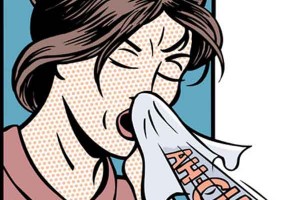I may get commissions for purchases made through links in this post.
It’s common knowledge isn’t it?
That those little static ‘shocks’ when you touch something are caused by dry indoor air.
But do you know the most common cause of low humidity levels in the home?
It’s air leakage.
The #1 thing to do to protect yourself and your family from too dry air
Cold air entering your home heats up which leads to a drop in relative humidity.
Ergo, air sealing, caulking and installing weather strips, is the most efficient way to maintain healthy, comfortable relative humidity levels in your house.
The smartest thing to to is to nip the source of the dry air in the bud.
[bctt tweet=”If there’s significant air leakage in your home, a humidifier is merely a band-aid solution.” via=”no”]
Inspect cracks, plumbing and telephone line openings fan covers on walls, the basement, furnace vent stacks, fireplace chimney siding, other outside locations where two different types of material meet.
These are the main cause of excessive dryness in the home.
Fix those leaks first before emptying the ocean with a thimble.
What you should know if your home has a modern forced air heating system
So you got air leakage. You may be inclined to think that you should close off registers and vents right? Not so much. It’s an old wives tale that this lowers your heating bill.
Blocking vents of modern forced air heating systems throw the system out of balance. By messing with how it inhales and exhales air the system has to work harder and could break down.
Save energy by letting heat flow evenly through your house. Blocking vents in certain rooms makes those rooms colder which will draw heat from other rooms in the house, lowering the overall temperature, causing you to crank up the thermostat.
2. Turn down the heat
Raising the thermostat when it’s cold is convenient but wearing a thick sweater instead is greener and healthier. The more artificial heat you use, the drier your indoor air will become. Dry air makes you feel cold and ill. So that sweater will make you feel good not only because you are saving money.
Creative & Simple Ways To Naturally Fix Too Dry Air In The House
3. Put pots on the radiator
Any pot or pan will do. Need your pans for cooking? I bet you have an old pie tin or cast iron pot you can use. Refill once in a few days. A frugal and effective method to increase your home’s relative humidity since you don’t have to buy anything.
Or buy an inexpensive radiator humidifier. These non-electric devices are specifically designed to moisten the air.
4. Dry clothes on the radiator
Similarly, drying your just washed pants or rain wet sweater on the radiator can also help to humidify the air inside. Don’t have still wet laundry available? Use the next tip.
5. The damp towel technique
Place a damp hand towel over a heat vent in the room. The warm air circulating by the furnace will evaporate warm water from the towel for a more humid atmosphere.
6. Put water containers on radiators
Place pots, kettles, pans or other vessels with water on heating ducts, hot air registers, and or radiators. The water evaporates into the air thus helping fix dry air. A cast iron kettle on a woodstove is a proven technique too. For more efficacy, place a partially open fish tank on a good location.
Even placing containers of water around your house will help add needed moisture. Be sure to check the containers regularly and add water as needed.
7. Shallow trays of water in direct sunlight
Sunlight shining through a window on the trays causes water vapor to fill the room it is needed.
8. Cook on the stovetop
Stovetop cooking releases moisture into the air. Your oven dries the air out even more, but your stovetop humidifies your home’s air.
9. Boil water
Quick, easy and effective. Just boil water in a large pot to raise airborne moist in your home. Keep the lid on as the water gets heated, and open it after the water has reached the boiling point. Make sure to place the hot pot in a safe place to avoid burns.
- Bonus tip: Add a few tea tree or eucalyptus essential oil drops. The scents have a soothing effect and help kill airborne germs reducing your risk on catching the common cold or flu.
10. Use your stovetop as a humidifier
Is your home’s air really dry? Turn a stove burner to low and place a teapot or saucepan or teapot with water on to simmer at a low boil. You can use a hotplate or heating element too. Make sure to keep an eye on the water level so the pot does not go dry.
- Bonus tip: while you are at it, add some cinnamon sticks, lavender (or other herbs or spices you like). You can throw in some orange or apple peels too for a great scent in the home.
11. Hack your oven cooking
The heat your oven emits dries the air considerably. Can’t use the more energy efficient microwave or stovetop instead? Place a teapot or another water container on the back burner. The heat of the oven warms it thus adding moisture to the air. This helps reduce the air drying effects of the oven to some extent. The larger the vessel, the more evaporation.
12. Use crock pots
Crock pots not only help you save money on groceries, when you fill them with water and plug them in and keep the lids off they help fight dry indoor air. Boiling water on the stove produces more steam in a shorter time but over time crock pots have proven helpful to many people. Just refill the water daily.
13. The simple but proven sponge technique
A wet sponge is commonly used in small cigar humidors. A soaked sponge exposed to the air helps increase humidity.
14. Make a DIY humidifier
You can choose from various types of simple, easy to make humidifiers. A popular simplified homemade humidifier technique is this. Punch about 20 holes in a large freezer plastic bag. Wet a big sponge and squeeze out the excess water. Place it inside the bag and place it in the room that needs its air dampened.
15. Spray your curtains
Dampen your curtains with a spray bottle. Open the windows to allow warm air in through the curtain filters. The water will evaporate causing your home’s rH to increase.
16. Air-dry your laundry inside
Hang your damp laundry up on a clothes drying rack near a radiator in the home instead of outside or by using the dryer. You’ll save energy at the same time.
Some people use a room fan to spread the dampness throughout the home and increase drying time.
17. Vent your electric clothes dryer inside
For less than 20 bucks you can buy a simple kit that lets you vent your dryer inside the home. The kit catches the lint in a water-filled plastic cup while the exhaust blows the hot moist air from the clothes dryer inside your house. This is a great way if your home’s air is really dry. It really works and adds extra heat to your home too.
- Warning: Don’t use if you have a gas dryer. Its safe only if you use electric.
18. Leave the bathroom door open
It will allow the damp air to spread to the other rooms. Works best during showering but for privacy reasons you could opt for leaving the door after your hot shower.
19. Use a bathroom fan
During and/or after showering and bathing, use your bathroom fan, or even better, a room fan to push the damp air out of the bathroom. You are not only making use of the humidity but are saving energy at the same time since you don’t have to heat the air that would otherwise have left your home through the exhaust fan.
20. Leave water in the bath tub
After you step out of your soothing, sleep inducing hot baths, let the water sit and cool off. The large body of water evaporate into the air making it an efficient way to fix too dry air.
- Warning: have small children? Best not use this method. Also, make sure to ventilate well to avoid harmful mildew and mold (which will force you to have to reduce your home’s humidity, as well as get rid of the mold)
21. Leave the dishwasher door open
Don’t use the drying cycle. Leave the dishwasher door open instead to let the steam flow into your home. Air drying your dishes lowers your energy bill and humidifies your home for free.
22. Make use of potted houseplants
Houseplants have various benefits, for one they help humidify your abode by a process called ‘transpiration’. Plants take up water from the soil with their roots. It then travels up all the way to the pores underside the leaves where moisture is released to the air.
- Bonus tip: place your plants in a bed of pebbles with about an inch of water. Or fill shallow trays half full of gravel and cover the gravel with water. Place the potted plants on top of the gravel.
Before you run off to the store to get some houseplants keep this in mind.
Various plant species need high relative humidity levels to thrive. Get a plant that can survive dryer circumstances. Regularly watering and misting will help your indoor greenery flourish too.
23. Vases with (or without) flowers
Vases with flowers add to the atmosphere in several ways. Flowers smell nice, look great, and the water aids the relative humidity. Grocery stores offer inexpensive bouquets or you can pick flowers from your yard or out in the wild. Place several vases and spread around the house.
Don’t fancy flowers? Some big tree branches can look great in the home too. Make sure to keep them out if you are allergic to trees pollen, a common allergy trigger.
Or just add vases with only water. They match your interior better than cooking pots and pans.
24. Simply a spray bottle
Get a spray bottle (for plants, cleaning products, or the cat) fill it with (warm) water and spray into the air every now and then. The finer the mist the more effective it is.
25. Build an indoor water feature
Build or purchase an indoor waterfall. It allows water to flow with maximum contact with the air. Simple DIY solutions involve a cylinder filled with pieces of plastic and a fan pushing air through.
26. Indoor fountains
Decorative desk-top fountains and other misting fountains can help optimize local humidity. Keep in mind to ensure these devices stay clean and free of mold.
- Added benefit: the moving water has a calming effect.
27. Vaporizers
Who doesn’t know the good old vaporizer used during the common cold. They can be used to humidify your home too. They require virtually no maintenance, and are cheap.
When natural ways don’t work
Clever, ”MacGyver-ish’ even, as these remedies may be, sometimes radiator pots and hanging laundry just don’t work.
When these theoretically effective measures in reality turn out to be like drops on a hot plate you may have to take out the big guns. You will want to either see a measurable difference, or experience a noticeable difference.
In these cases you need to get a whole house humidifier. In case you need to humidify just one bedroom take a look at these best selling room humidifiers.
For most households these devices, when properly maintained and in combination with other measures, will suffice.
In extreme cases you may have to resort to…
28. Getting a huge humidifier
Tricks and hacks can help but some cost energy and require effort. Getting a quality humidifier has its benefits. Which humidifiers are recommended?
You tried various of these humidifying hacks and came to the conclusion you need a large humidifier?
Don’t settle for a little table-top device. Those drug store units that can hold a quart of water won’t cut it.
Get a big ass humidifier such as a cabinet or chest humidifier that can hold a whopping 10 to 20 gallons. Even better if it has a humidistat so you you don’t have to turn it on and off (goes automatically)
These things will set you back about 100 bucks but they last for decades. Additional benefit, when you move to a bigger abode you can take it with you. It’s powerful enough to treat larger areas.
How to measure humidity
Purchase an inexpensive humidity gauge (hygrometer) at the hardware or home store. With this device you will know exactly what the humidity levels in your home’s rooms are.
Knowing your home’s humidity levels will help you fix the dry air problem. Hygrometers can tell you that the humidity in your living room is 60% and that of your bedroom is 30% (just to give an example).
Experts recommend to place hygrometers in these areas (bedrooms and living room) since you spend most time when at home.
Appropriate rH levels also help you sleep better at night.
Why dry indoor air is your invisible enemy
Do you often wake up thirsty? Coughing even? These may be indications there is not enough humidity in your living space.
Other symptoms include, dry skin/hair, scratchy throat/nose, bloody nose, aggravated respiratory ailments (increased allergy and asthma symptoms), and people catching colds more easily. Other effects are severe muscle cramps, heat exhaustion and/or fatigue.
Those annoying electric discharges can damage electronic devices. Computers for example can be damaged considerably.
Are you safe from icky dry air lurking in your house?
Image credit: Pixabay
























This is detailed and comprehensive. Thanks.
Thank You for these awesome tips. I feel that getting a humidifier is the best and easiest way to humidify the home. It is better to consult a trained and experienced HVAC professional before getting one.
Let me guess…. You sell them, or work in the HVAC trade lol.
I currently have a humidifier., however, still waking up in the morning with a dry, scratchy throat, even after gargling.
This is why I came to this page. Love the crock pot idea!
Yep humidifier are the best bet.
Unfortunately I have heating that I have no control of. It’s like a baseboard heater, but it goes from floor to windowsill.
I wake up day after day with a really dry nose that bleeds.
I desperately need to get humidity in my apartment.
So basically live in a pool!!
Thanks, I just turned the shower on hot and filled up the bathtub, boiled two pots of water and put pots of water by the heating element, in addition to my two humidifiers. The humidity in my house went from 11% to 27% so far and is still climbing. I was dying of dryness. Thanks!! (Its 6F right now)
I live in an apartment where we have individual forced air heat. Mine always blows dry air. I wake up cotton mouth and a bad cough every morning. Bought a humidifier two days ago to help. Took all day to get rid of the cough I already had and went to bed without coughing. Feel like I woke up back at square one. What can I do? I am constantly getting sick.
Thanks for very good advise. We are in a camper van, in cold temperatures and the small space heater is drying the air to a point that makes it very uncomfortable. We’ll use some of the most basic ideas proposed here. Again, thanks!!
Hi Rafael, living in a camper van is great. Thanks for your comment.
Your feet get cracked
You get eczema
Dry lips
Watery eyes
Nose bleed
These are all symptoms of dry air in ur home.
11. Hack your oven cooking
The heat your oven emits dries the air considerably. Can’t use the more energy efficient microwave or stovetop instead? Place a teapot or another water container on the back burner. The heat of the oven warms it thus adding moisture to the air. This helps reduce the air drying effects of the oven to some extent. The larger the vessel, the more evaporation.
1) Heating air does not dry it out and if it is done by a gas oven a byproduct of burning gas is water so it will add water. Running a gas oven that is not properly vented is “DANGEROUS”. And if properly vented the dryer air from outside may actually dry the house more.
Great work! Thank you for this amazing piece. It’s packed with so many helpful tips all in one place.